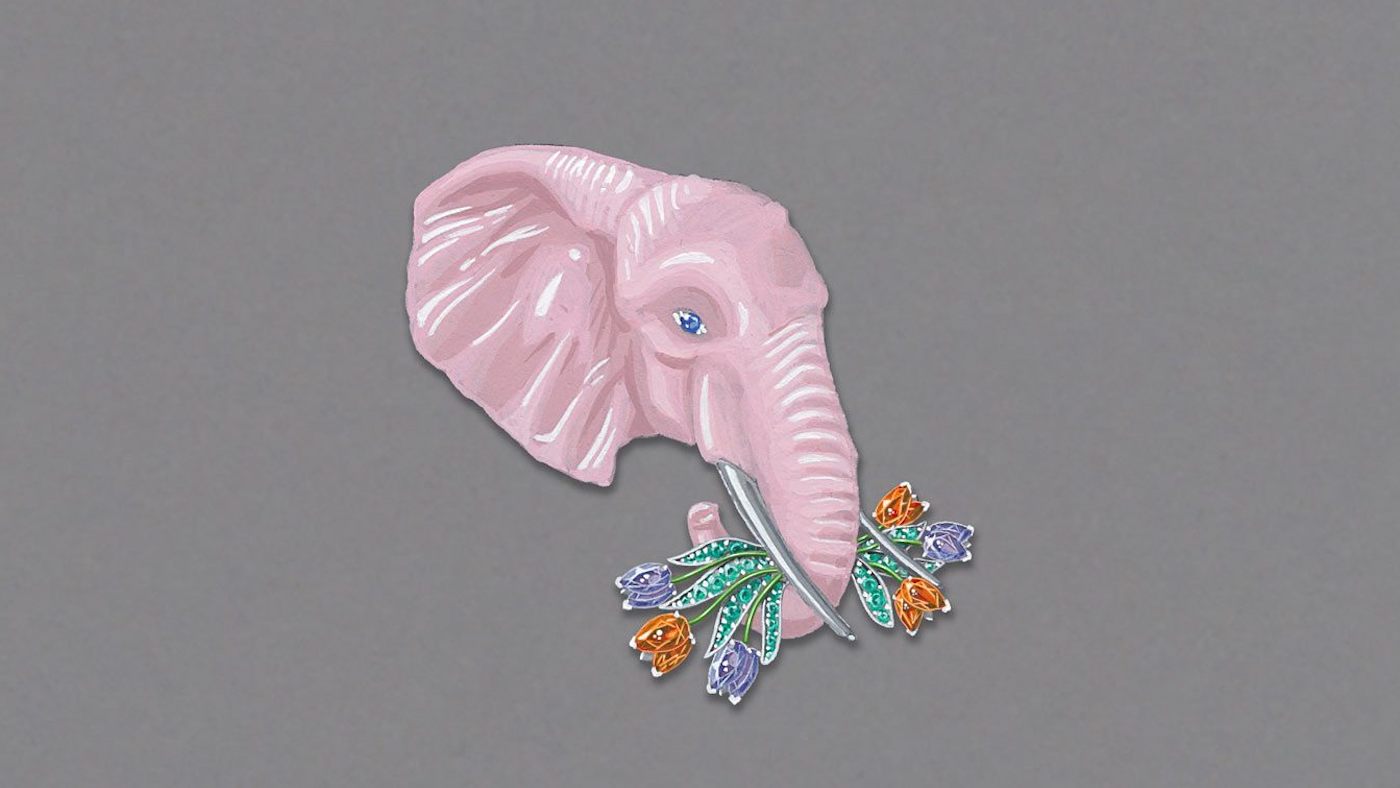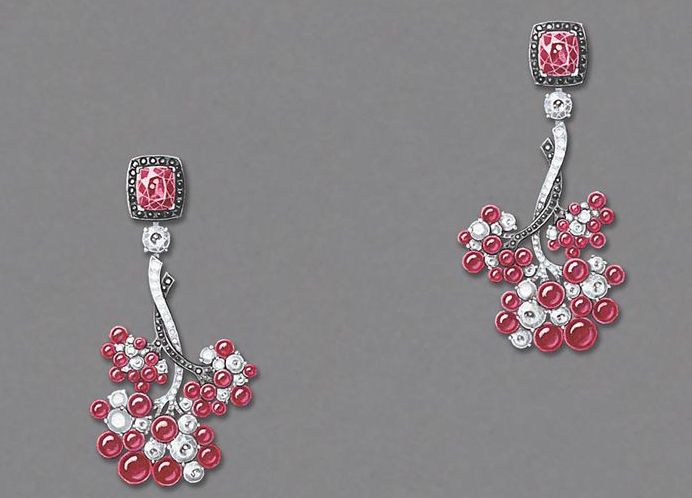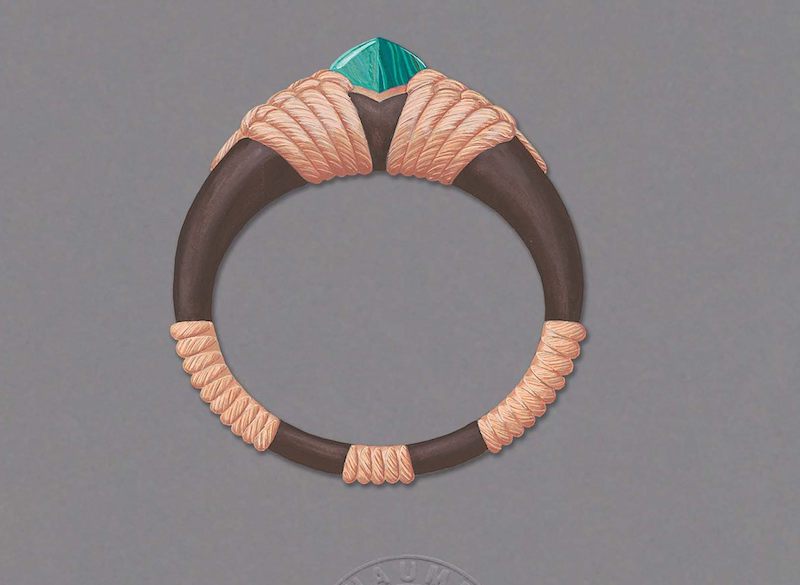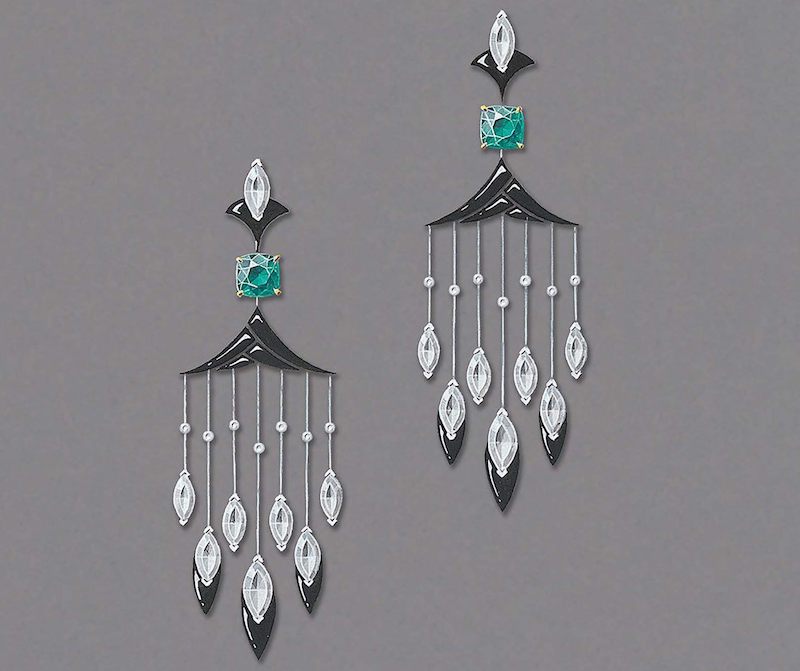Around the world with Chaumet
The Parisian house demonstrates why its world class savoir faire has maintained international appeal through the centuries

In sentiment and splendour, few love tokens rival a trio of Chaumet acrostic bracelets from 1810. Finished by the maison's founder Marie-Étienne Nitot, the delicate gold-set creations were a wedding gift from Napoléon Bonaparte to his second wife, the Austrian Archduchess and future Empress of France, Marie Louise.
Acrostic jewels are a form of wearable poetry: each gemstone represents a different letter of the alphabet and as such, the jewellery 'spells out' a secret love message. The Empress' three bracelets spell her own name, Napoléon's, the couple's birthdays and the date of their first meeting in Compiègne, in the north of France, with multi-coloured dot-like jewels.
Earlier this year, the set of bracelets formed part of Les Mondes de Chaumet (The Worlds of Chaumet), the luxury brand's blockbuster exhibition in Tokyo, Japan. Installed at the Mitsubishi Ichigokan Museum, the exhibition grouped 300 rarely seen objects, drawn from the Chaumet archives, pulling in pieces from 40 private collections and 15 museums including Paris' Petit Palais, the Louvre and Switzerland's Einsiedeln Abbey.
The Week
Escape your echo chamber. Get the facts behind the news, plus analysis from multiple perspectives.

Sign up for The Week's Free Newsletters
From our morning news briefing to a weekly Good News Newsletter, get the best of The Week delivered directly to your inbox.
From our morning news briefing to a weekly Good News Newsletter, get the best of The Week delivered directly to your inbox.
Designed in 1894 by British architect Josiah Conder and recently restored, the Mitsubishi Ichigokan Museum is a Queen Anne-style red-brick building located in Tokyo's built-up Marunouchi district. In addition to hosting temporary exhibitions curated in partnership with institutions such as Paris' Musée d'Orsay (2017) and the Prado Museum in Madrid (2015), the museum safeguards the estate of late French gallerist Maurice Joyant, a collection that includes 250 works by of Belle Époque artist Henri Toulouse-Lautrec. Given its French connections, The Mitsubishi Ichigokan Museum is well-suited to celebrate Chaumet, arguably the most Parisian of heritage jewellers.
Marie-Étienne Nitot - a former apprentice to Marie-Antoinette's jeweller Aubert - set up his own business in 1780. He weathered the Revolution and his ties with Madame Déficit well: In 1802, Nitot was named official jeweller to the court of Napoléon Bonaparte and within a decade he became the first jeweller to open on Place Vendôme, where the brand has remained to this day.
Despite the fall of the French monarchy, Chaumet's heritage is replete with royal and aristocratic collaborations. From its Place Vendôme ateliers, the maison has created more than 3,500 tiaras for a client list that reads like a roll-call of European monarchs; it includes Louis-Philippe, King of France, Queen Victoria and Spain's King Alfonso XIII, who presented the future Queen Ena (née Victoria Eugenie of Battenberg) with a Chaumet turquoise fleur-de-lys tiara to commemorate their engagement in 1906.
Many of Chaumet's most famous archival pieces were commissioned by Napoleon himself: Nitot created Joséphine Bonaparte's wedding parure as well as the ruby and diamond coronation crown presented to the Emperor's second wife Marie-Louise, Duchess of Parma. "Chaumet has always been a choice of distinction", says Jean-Marc Mansvelt, CEO of Chaumet since 2015.
A free daily email with the biggest news stories of the day – and the best features from TheWeek.com

A pair of berry-like earrings taken from Chaumet's Les Mondes de Chaumet Trésors d'Afrique high jewellery collection.
Les Mondes de Chaumet exhibition in Japan is a celebration of the brand's savoir faire that throws a spotlight on Far Eastern design influences that have long since informed the atelier. Included in the showcase is a 1925 vanity case set with rose-cut diamonds and bordered by deep-blue lapis lazuli, at its centre sits a panel of pale green nephrite, engraved with an exotic floral motif. Elsewhere, a 1977 torque necklace by Chaumet collaborators Béatrice de Plinval and Pierre Sterlé imagines a ginkgo leaf – the official emblem of Tokyo and a symbol of longevity – in gold, bronze and diamonds. "To be successful in Japan for any brand is extremely meaningful", explains Mansvelt. "It's a guarantee of the [standards of] excellence you set for yourself."
Chant du Printemps, a special high jewellery collection finished in time to coincide with Chaumet's Tokyo exhibition, marks the brand's latest tribute to Japan. Unique pieces – a pair of rings, a necklace, a bracelet, earrings and a brooch – imagine bursts of cherry blossom thanks to pulpy clusters of rubies, rhodolite garnets and diamonds laced with subtle whispers of onyx.
Chant du Printemps is the second chapter of Les Mondes de Chaumet high jewellery collection, a precious tour of the world in three acts. For the first stop, the marque chose Russia, presenting Promenades Impérial in January at its storied Place Vendôme home – it's in the site's Grand Salon that Frédéric Chopin composed his last Mazurka in the 19th century.
Historically, Chaumet has enjoyed strong ties to Russia, creating spectacular one-off designs for illustrious clients including the Grand Duchess Maria Pavlovna of Russia, considered one of the greatest hostesses of St Petersburg and one of last of the Romanovs to escape Revolutionary Russia. One of the best examples is the Princess Yusupov", says Mansvelt, referencing Princess Irina Alexandrovna of Russia, who married Imperial Russia's richest bachelor Prince Felix Felixovich Yusupov in 1914. "We did incredible creations for her. Unfortunately, all of them disappeared; we have drawings and many pictures of her wearing [the] pieces".
Chaumet's jewels are fit for a modern-day tsarina: the brand looked to traditional Russian 'kokochnik' headdresses for inspiration as well as some of the more exuberant historical tiaras kept under lock and key at Place Vendôme to create a collection of great technical virtuosity. Earrings, for example, look like intricate snowflakes set with marquise and brilliant-cut diamonds, and are punctuated with a single pale pink Padparadscha or Ceylon sapphire.
Perhaps the most complex piece from the Promenades Impérial range is a transformable white and pink gold necklace set with pear-shaped and cabochon-cut Ceylon Padparadscha sapphires, in addition to oval, marquise and brilliant-cut diamonds, that can be worn in ten different ways. "It's interesting; at the end, it's extremely technical but nobody is interested in the technique", says Mansveldt." It's the beauty. You feel the emotion, rather than the technique".

An ebony wood-based bangle from Chaumet's Les Mondes de Chaumet Trésors d'Afrique high jewellery collection.
In July 2018, Chaumet's Grand Tour reached its final stop with Trésors d'Afrique, an ambitious collection spread across five themes, including Ronde de Pierres which captures the spirit of traditional beaded and hooped adornments worn by East Africa's Massai people with a rainbow array of swirling and arching pieces composed of Mandarin garnets, sapphires and emeralds as well as red and black spinels and brilliant-cut diamonds.

A pair of Cascades Royals earrings from Chaumet's Les Mondes de Chaumet Trésors d'Afrique high jewellery collection.
Cascades Royales re-imagines the opulent pendants adorning traditional East African headdresses as tiered necklaces cast in emerald, diamond and onyx and set using Chaumet's signature 'fils couteau', an intricate technique that requires an artisan to place gems along thin tracks to achieve an almost invisible setting. More abstract are the Terres d’Or rings which draw on the graphic patterns of traditional Kente cloths from Ghana. Great centre stones of yellow Ceylon sapphire are surrounded by a geometric puzzle-like plateau of diamonds and purplish 'pigeon-blood' rubies. More esoteric still are a group of dramatic cuffs made for the 'Talismania' line which use smooth ebony as a base for vibrant gems including lapis lazuli, fuchsia chrysoprase and chalcedony, all set in yellow and pink gold. Chaumet's African tour de force reaches its peak with the Espiègleries – or 'mischievous' - collection. Designed by contemporary Kenyan artist Evans Mbugua, Chaumet's mischief-makers are a sextet of adorable animal brooches, among them a pink opal elephant carrying a bunch of precious sapphire, tanzanite and mint tourmaline flowers in its trunk. There's also jolly looking giraffe whose head is stuck in a cloud of rock crystal and whose distinctive coat pattern is a patchwork of 'Grand Feu' enamelling cast in the pan-African colours of red, gold, and green.
Mbugua's exotic and playful designs may seem worlds apart from Chaumet's regal parures and Napoleonic tiaras but in truth there's a subtle connection: a full-hearted embrace of the highly decorative and the ornamental which transcends time and geographical boundaries. As Jean-Marc Mansvelt succinctly puts it, "It was important for us to demonstrate that at the centre of Place Vendôme, you can be a brand [that is] open to new options, new worlds".
Discover more of Chaumet's centuries-strong heritage with the maison's 'Mémoire' trilogy of books, presented in partnership with Assouline.
-
 Political cartoons for December 17
Political cartoons for December 17Cartoons Wednesday's political cartoons include healthcare costs, the affordability hoax, giving up pencils, and more
-
 Trump vs. BBC: what’s at stake?
Trump vs. BBC: what’s at stake?The Explainer The US president has filed a $10 billion lawsuit over the editing of Panorama documentary, with the broadcaster vowing to defend itself
-
 Animal Farm: has Andy Serkis made a pig’s ear of Orwell?
Animal Farm: has Andy Serkis made a pig’s ear of Orwell?Talking Point Animated adaptation of classic dystopian novella is light on political allegory and heavy on lowbrow gags